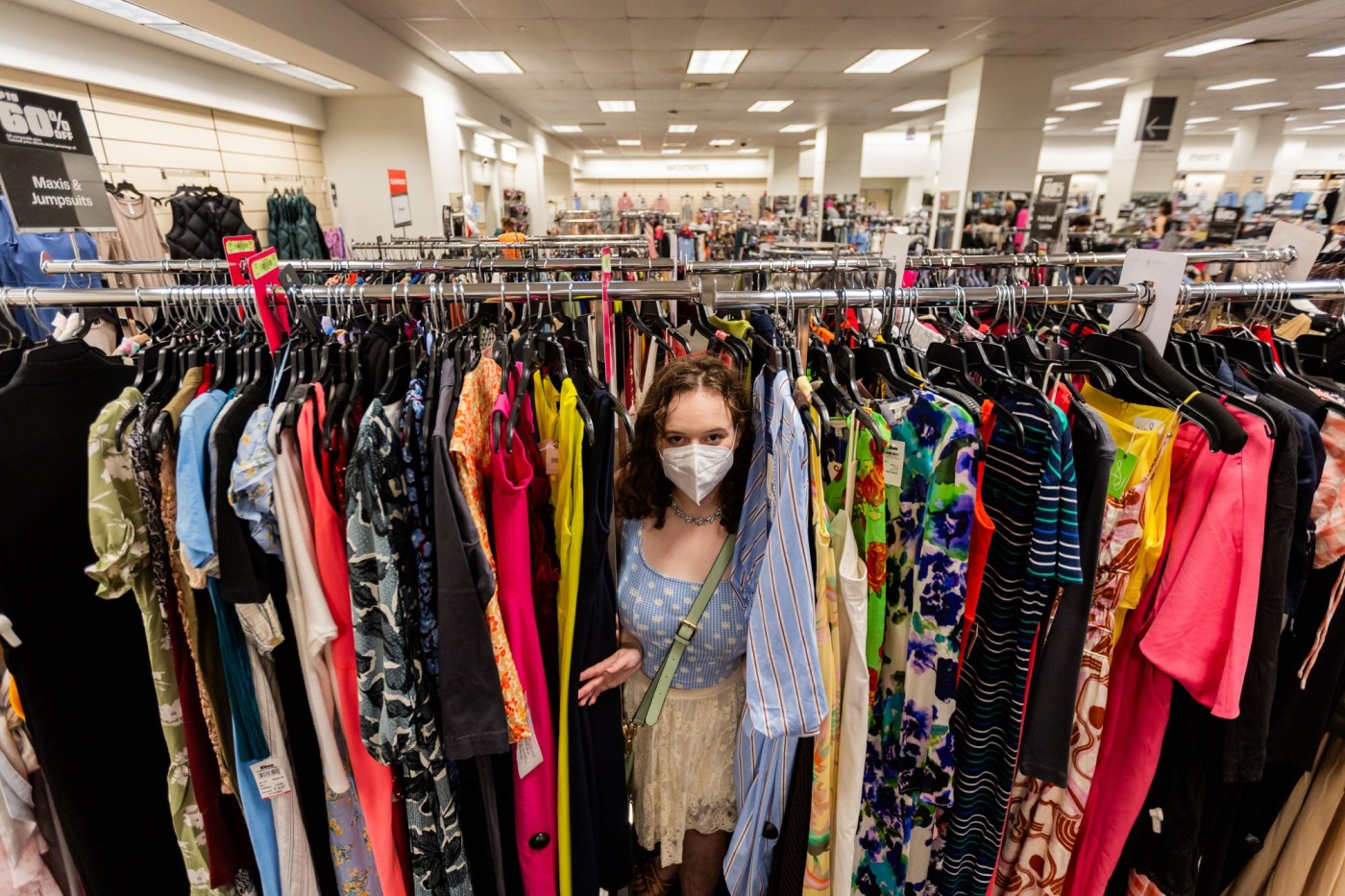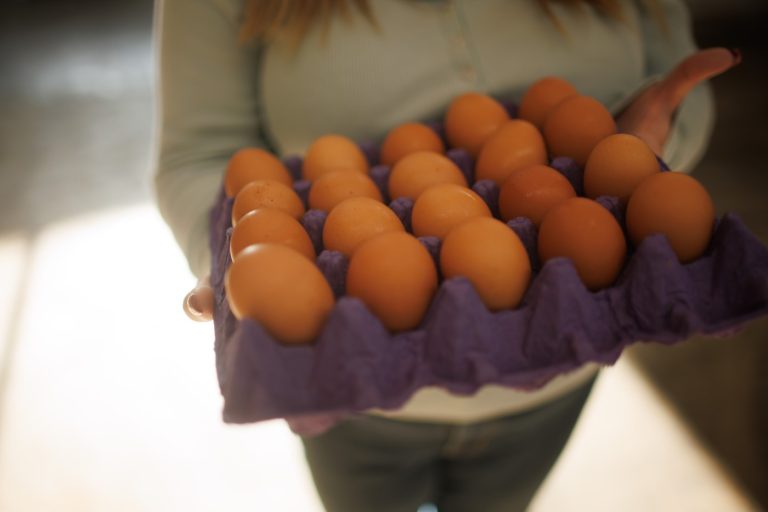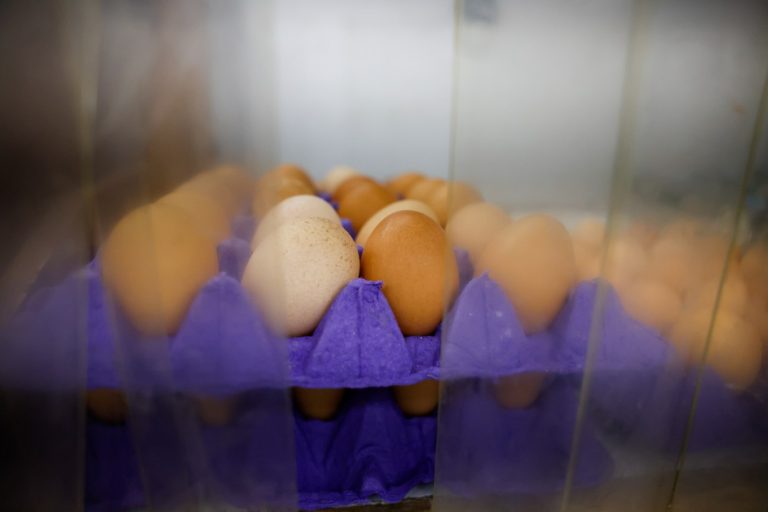In recent weeks, the concept of “underconsumption core” has gone viral on TikTok — the land of influencers, shopping hauls and short-lived fads. It echoes an earlier trend in which users discouraged others from mindless buying.
Rosie Albrecht, 26, from Chicago, has been a regular presence on the social media platform for the past five years.
Last year, she found her niche alongside other “deinfluencers.”
“I was shopping in Target — it was the big, Goth Target on State Street, you know the one? Yeah, we all know the Goth Target,” Albrecht said, laughing. “And I was just thinking about how there were all these videos that I kept seeing online, all the time, of people being like, ‘Come shopping at Target with me!’ ‘Let’s go do a Target run!’ Or my least favorite, which was, ‘Here are the things you need to get at Target!’”
Then she asked herself: “What if I made a video that was the opposite of that? Here’s me in Target, just doing my normal shopping, but instead of telling people to buy stuff, I’m talking people through why I’m not buying stuff.”
That first deinfluencing video blew up. “I was like, ‘OK, I guess I’m gonna make this my thing now,’” said Albrecht, who has over 40,000 followers.
These deinfluencing and underconsumption trends present increasingly popular ways to push back against a culture of consumerism, fast fashion and overspending promoted by lifestyle influencers on social media who post videos of their latest shopping spree as packages comically pile up in the background, all carrying brand names to promote.
Many young social media users try to keep up with these lavish, but mostly unattainable, levels of consumption. Others worry about the environmental impacts as unrecyclable, cheap products get dumped in landfills: In China, the world’s largest textile producer, more than 26 million tons of clothes are thrown away each year.
“Underconsumption core” normalizes conscientious purchasing habits of high-quality or secondhand items and a reliance on tried-and-true products. The suffix “core” is used in slang on social media to describe an aesthetic, vibe, trend or movement.
Google searches for this term surged by 1,150% in the last two weeks of July after it went viral on TikTok, according to digital marketing firm Webbee.
Whether this virality can sustain a long-term movement toward environmentally friendly consumer behavior remains to be seen, especially when social media content is driven by clicks, according to Curtis Puryear, a computational social scientist and postdoctoral fellow at Northwestern University who studies the intersection of social media and moral values or beliefs.
“There is a possibility that social media actually does not scatter our attention across a million issues that are always changing, but that what it actually does is focus our attention on a smaller set of core issues that consistently rise to the top of our feeds,” Puryear said.
So even if some social media movements appear short-lived, they might come back and manifest in slightly different ways: A few months into deinfluencing videos that were starting to lose steam, underconsumption core emerged to breathe new life into a long-standing concern for the environment and overbuying.
Albrecht’s TikToks under @circesporkroast have accumulated almost 5 million likes; in her most-viewed ones, she wanders around in dollar stores and discount retailers upon followers’ requests and examines the quality of eye-catching items or viral products, discussing whether she already owns a product that can serve the same purpose and if she actually needs it.
She calls her approach “mindful consumption,” which takes into account the sustainability of a product and its impact on the environment. It’s a term Albrecht uses interchangeably with deinfluencing and underconsumption core.
In other popular videos, Albrecht employs rapid-fire deinfluencing — resharing several videos of “random” things and novel products that viewers might feel compelled to buy and, in less than two minutes, explaining why they are likely unnecessary purchases.
“It wasn’t just the fact that the (videos) were getting a lot of views. I was seeing so much positive engagement in the comment sections of these posts,” Albrecht said. “It wasn’t just people being like, ‘Oh, I love this.’ It was people being like, ‘I’m so relieved to see this content.’”
A trendy anti-trend
Rosie Albrecht, 26, from Chicago, records a video for TikTok at the State Street Nordstrom Rack in Chicago on Aug. 9, 2024. “I absolutely never buy something if the main reason I buy it is the cute packaging. None of us are immune to cute packaging. But we can resist it,” she said. (Tess Crowley/Chicago Tribune)
For every video advocating for underconsumption, many more exist with the app’s e-commerce feature, TikTok shop, which lets influencers post affiliate links for their followers to buy products directly on the platform with less than a mouse click: the tap of a finger.
“I personally believe that as long as we are in this deep, late-stage capitalist influencer culture, there will be a need for my type of content,” Albrecht said.
Throughout history, humans have looked to social signaling from others to make sense of things. For example, if there’s a loud crash on a busy street, pedestrians will likely look at each other to see how to react and decide whether they need to run and hide, Puryear said.
“It’s a core part of how humans navigate the world, and I think social media is often very similar to that kind of situation,” he said. “We look to see how other people are responding. That’s normal, and I think it is usually adaptive.”
Albrecht acknowledges this but adds that social media users have reached a breaking point in their lack of trust in influencers and the unrealistic, accelerating cycles of trends. They need a reminder that they can make purchasing decisions for themselves, she said, instead of staying trapped in the “hamster wheel” big corporations have put them in.
“If we stop buying things at the speed that they want us to buy things at, then their business model falls apart,” she said. “If we’re buying things more slowly and more thoughtfully, we will want to buy things that are better quality and last longer.”
A desire among consumers to make mindful, ethical purchases is not new and has also occurred independently from social media trends. In Chicago, word-of-mouth and curious walk-ins drive a lot of business to zero-waste stores like The Unwaste Shop at 1108 W. Madison St. in the West Loop, which offers plastic-free, reusable and compostable items, as well as nontoxic personal hygiene and food products.
Sherry Skalko, left, founder of Reduce Waste Chicago, a nonprofit that works to address climate change through waste reduction, and her friend Inka Cherry pick up Christmas tree lights at Unwaste Shop, 1108 W. Madison St. in Chicago, on Dec. 29, 2023. (Terrence Antonio James/Chicago Tribune)
“It’s very common for my feed to show a woman of my age doing a haul where she’s purchasing 15 items off of Amazon, and some of them she’s keeping, some of them she’s not,” store manager Randi Alexander, 35, said. “And just thinking through the entirety of the impact of that haul is something that I find to be really interesting and, in some cases, stressful.”
She said she worries about lax labor practices and exploitation in global factories, individual plastic bags for every product, and packaging that gets thrown away and sent to landfills that emit warming greenhouse gases or put in the recycling bin, where little of it ultimately gets recycled.
But Alexander has noticed an uptick in interest in underconsumption, mostly from younger generations.
“People are being very in tune with that conscious consumerism and how (it) can really benefit themselves and also benefit a wider breadth of their community and their circles,” she said.
“I can’t tell you how many young people come through our doors on a daily, weekly basis that are just so impressive,” shop owner Todd Barancik said. “When I was their age, I wasn’t focused on the environment. I just wasn’t intentional, wasn’t as conscious of a shopper.”
Alexander and Barancik hope these movements will last, but trends are so cyclical and market-driven that an economic bounce back for younger generations might lessen future interest in underconsumption.
Economy, climate and mental health
Rosie Albrecht, 26, from Chicago, examines clothes for a TikTok video at the State Street Nordstrom Rack in Chicago on Aug. 9, 2024. (Tess Crowley/Chicago Tribune)
Young adults in America — especially older Gen Zers and younger millennials — are, on average, less likely to own a home and earn as much as older generations did at their age. That kind of economic insecurity has combined with chronic stress from destabilizing social forces beyond the pandemic, like climate change, police violence and mass shootings, to contribute to high levels of anxiety and depression among younger generations.
This was part of the findings of a study released in November led by Northwestern University researchers including Sarah Collier Villaume, a postdoctoral fellow who studies the impact of stressors on young people’s mental health.
“I certainly can imagine that taking steps towards deinfluencing and underconsumption might give them a sense of control over the future, which I think is hard to get as one small person in this big and threatening world, from a climate perspective,” she said.
As millennials, Gen Z and Gen Alpha get acquainted with the soaring prices of home ownership, the consequences of inflation and the shortcomings of salaries in the face of increasing costs of living, Collier Villaume said they wonder: “Where is there a place for me?”
“I think it’s what a lot of teens and 20-somethings are asking,” she said. “And I think it’s partially cost of living, it’s partially climate, it’s partially a lot of other destabilizing forces, geopolitically.”
Instead of being told every day that they need to buy the next new thing to be happy and complete when they can’t afford it, she said, social media users might feel more compelled to adopt a different approach to their consumer habits if they find like-minded people online that encourage them to shop secondhand or re-wear old clothes. It can initially feel like a radical act but ultimately become an empowering experience, like Albrecht’s.
“Young people are saying: ‘Yes, the system is broken, but that doesn’t mean I have to be complicit in it; I can make choices not to contribute to fast fashion cycles,’” Collier Villaume said. “Maybe it’s a drop in the bucket, but if every one of us takes one of our drops back out, we are contributing to the future that we want to live in.”
Taking power back
Rosie Albrecht, 26, from Chicago, examines a $3.97 glass vase for a TikTok video at the State Street Nordstrom Rack in Chicago on Aug. 9, 2024. “I only buy vases at the thrift store. You can get such cool and unique ones there,” she said. (Tess Crowley/Chicago Tribune)
For as long as she can remember, Albrecht has been “anti-trend.” It doesn’t mean she’s not immune to what’s hot and fashionable — when she was in high school 10 years ago, she really wanted a pair of jelly sandals that made a comeback from the 1990s. But she resisted buying them.
“Then, what would you know? Within a year, it was ‘cringe’ to wear them.”
Since then, she has developed her own sense of style and enjoys wearing something she loves even if “everyone else has decided it’s uncool.”
“A lot of people are scared to depart from trends because then they have to discover what it is that they like. They have to discover their own personal style,” she said. “That is a journey that will necessarily take them through periods where they maybe mess up, where they do things or say things or buy things that are kind of cringy or kind of ugly or kind of weird. But we need to not be afraid of that because that is a necessary part of creativity.”
Albrecht considers her aesthetic maximalist, which can incorporate a mix of colors, patterns and textures. In her apartment and quirky outfits, it’s evident she’s a lover of color, glitter, knickknacks and rainbows — and she doesn’t see it as contradictory to her philosophy of underconsumption.
She might avoid buying fast fashion and trendy items but finds joy in making things by hand, treasure hunting in thrift stores, holding onto items instead of throwing them out and curating eclectic collections of mismatched belongings.
“That lends itself so well to maximalism,” she said. “A big part of mindful consumption is not just in what you buy, but in what you do with what you already have.”
She held a smiley face mug she’d repurposed as a pot for a hanging plant. “It’s cute, right?” She then tugged at a pearl necklace around her neck that she got as a hand-me-down from her mother.
Ultimately, Albrecht wants to share the empowerment she has felt from thoughtfully expressing her personality through what she owns, regardless of what influencers and big corporations are trying to convince her to purchase.
“In the moment, it can feel so good to sort of relinquish that responsibility … (not) to have to think about what to buy anymore,” Albrecht said. “A lot of people are sort of now realizing that they did relinquish that control and they want it back. And I want to try and help people get that control back.”












